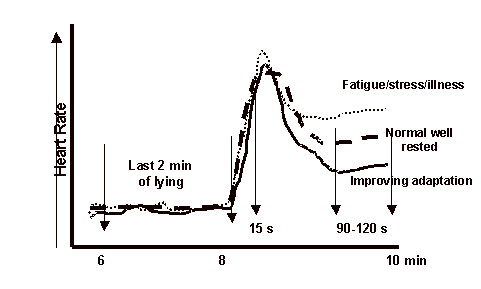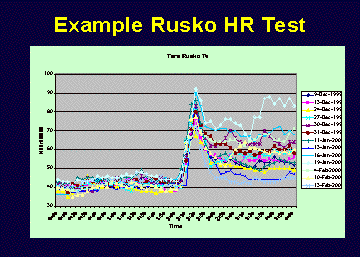
|
个人信息Personal Information
副教授
硕士生导师
主要任职:体育与健康学院副院长
其他任职:大连市体医融合与健康工程重点实验室 主任
性别:男
毕业院校:大连理工大学
学位:博士
所在单位:体育与健康学院
学科:运动人体科学
办公地点:副院长室(体育馆东区10)
联系方式:0411-84708541
电子邮箱:liuhaibin@dlut.edu.cn
鲁斯科心率测试
发布时间:2020-10-15 点击次数:
This is a very simple heart rate monitoring test that is currently in use with many athletes around the globe. A detailed method appears below, but essentially all you have to do is lie quietly in a comfortable position for a few minutes and then stand up and remain still for a couple more minutes. The test initiates a heart rate response to the standing motion (and gravity) that the body has to quickly adapt to. Since this test is done under a fairly sensitive control and feedback system, it responds to positive and negative training and competition loads, as well as the onset of illness and other stresses in a fairly sensitive and individualistic way.
Athletes should do this test at least once a week, on a morning when they do not have to rush out of bed. Ideally, it should be done on the same days of the week and in the morning immediately after waking, before the athlete gets out of bed. The test requires very little energy and can easily be done anywhere.
The test usually requires the athlete to have a recording/memory-type heart rate monitor or a standard display heart rate monitor. If the athlete does have a recording heart rate monitor, it should be set to record every 5 seconds of the last 4 minute period of the test. If the athlete does not have a recording heart rate monitor, then the athlete should just record and calculate 3 data points visually:
Start by lying down and waiting until you are relaxed, and your heart rate has stabilized. Start you watch. At 2 minutes stand and stay standing for another 2 minutes. The important heart rate values are:
1)the average of the 2 minutes of lying,
2)15 seconds after standing and
3)the average of the last 30 seconds of standing (i.e., the 90-120th seconds after standing).
The following charts give an idea of what data may look like, together with some basic interpretive guidelines.

In the above sample diagram, the suggestion is that a clearly elevated heart rate average between 90 and 120 seconds after standing (i.e., 8-10 beats + above normal) is a possible sign of some failure to recover adequately. This may be due to hard training and poor recovery time, the onset of some illness, or other forms of life stress. On the other hand, if you the heart rate is dropping slightly, then this may be due to some positive adaptation to training and competition. You can also interpret the shape of the heart rate spike caused by standing. A steep climb and quick drop in heart rate indicates a heart that is more rested and sharp than a spike that climbs slowly and descends slowly. Keep in mind that the results are very specific for an individual. No comparisons can be made between athlete's and a profile of each athlete must be made to know what values mean for each person.
This test is used regularly by all of the Canadian National Ski Team athletes to monitor fatigue and adaption levels. It is generally done one day a week, on the same day that other regular testing would be done. It is done before the athlete gets out of bed in the morning. During hard training periods or periods of extreme stress (altitude adaption, travel, training camps, etc...), the test is generally done every day. The national team uses Polar recording heart rate monitors (such as the Polar Accurex Plus) and the data is downloaded and graphed for interpretation by coaches using the Polar computer interface.

References from: http://www.ilog.ca/help/Rusko_Heart_Rate_Test.htm
